2025 Guide to Wine Tasting in Paso Robles: The Wild West of Wine, Food, People and Touring Options
Double down and plan to spend more time in Paso Robles than you might think. There’s almost too much to taste, eat, and experience here, i.e. something for everyone. Embrace the Paso lifestyle and local wine and food culture. This is not like Napa or Sonoma Valley or most other wine regions. There’s some “Wild West” lingering here, and the locals like it that way.
Paso Robles (PR) is well known for its Rhône-style wines (Syrah, Grenache, Mourvèdre), Zinfandel, and bold Cabernet Sauvignon, but there’s so much more. Over 60 types of wine grapes are planted and winemakers have countless options of wines to produce. This is where consumer abundance begins. But first, let’s talk about growing grapes and why there’s so much diversity.

Unique Terroir
The variation in the geology of the region starts in the western parts of the AVA with proximity to the Pacific Ocean and the weather it stirs up. There’s a huge shift from fog bound cool mornings to hot and sunny afternoons near the coast. A diurnal shift of 40-50°F is not uncommon. On the east side of the region, it might be sunny from morning until sundown. There are also distinctive land formations and vineyard elevations from 700 to 2,000 feet. Soil types – over 30 different classes of soils – create micro-terroirs that affects wine varieties planted and wine styles.
Also consider that there are over 60 different grape varieties plants across the 11 nested AVAs of the Paso Robles AVA (American Viticultural Area). Winemakers have experimented and dialed in the art of pairing soils – calcareous shale, limestone, sandstone, marine fossils, and volcanic soils – with the right grape varieties.
The Adelaida and Willow Creek Districts are the closest sub-AVAs to the ocean and experience extreme maritime effects. Its limestone-rich soils present wines with bright acidity and minerality. Contrast that to the east side where the Estrella and Geneseo Districts have alluvial and sandy and gravelly clay soils that are well drained and the wines are more fruit-forward as a result. Enough about land, soils and terroir effects. What about the Art of Pairings – great wine, food, and interesting people?
Where to Taste, Dine and Visit
I recently spent 3.5 days on a press trip visiting the Paso Robles AVA and touched 35 wineries total. This would not have been possible without organization by the Paso Robles Wine Country Alliance. They selected specific wineries representative of the AVA, and this article is a short list of some of the best wineries to visit and taste. My experience is available to everyone not just wine media, although you might not meet as many winemakers. Each day, wineries were paired by area-location or by theme-interest.
I highlight the host location and wineries at each stop, as well as the restaurant partners that fed us. Here is what I learned, loved and recommend. Remember, budget extra time when you plan this trip!
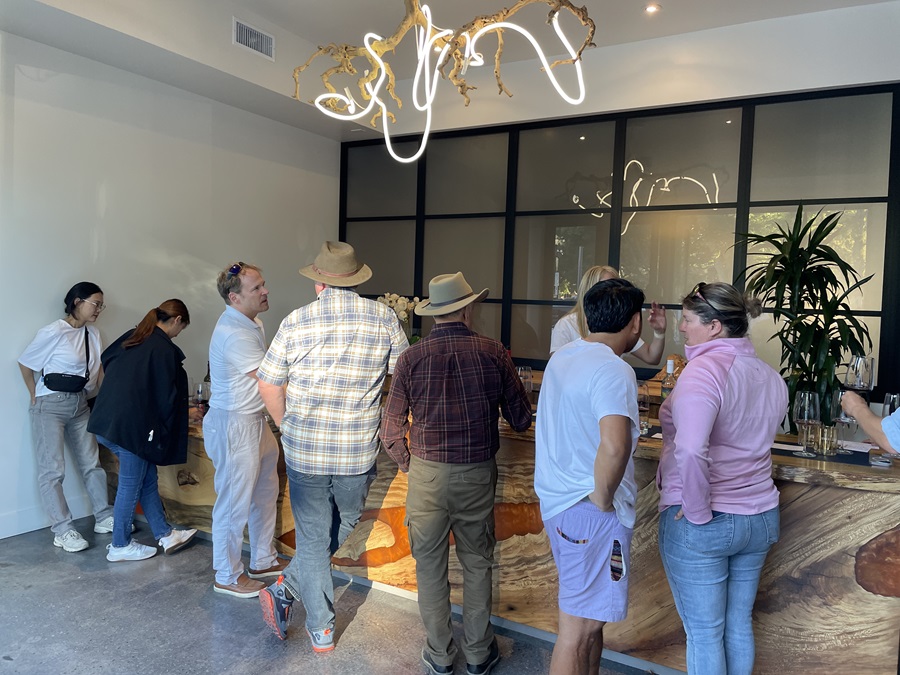
Downtown Paso Robles
There are 22 downtown tasting rooms around the historic city park in Paso Robles. We started the evening on the historic downtown square in Paso, at the new and very popular Hope on Park, the urban tasting room from Hope Family Wines. Chuck Hope was one of the pioneers of PR wines and launched his brand in 1978. His son, Austin Hope, runs their winery group today, comprised of six brands and over 200K cases of wine. You can taste some of their smaller production boutique wines here as well as their more available labels. Try the sidewalk bar on the square and inside at the speakeasy. Hope Family is well known for their Cabernet Sauvignon wines, and the 2021 and 2022 Cabs were showing well. I particularly enjoyed the unoaked, low alcohol, and value-priced Austin Chardonnay at only $20/bottle.
Vermentino and Fish
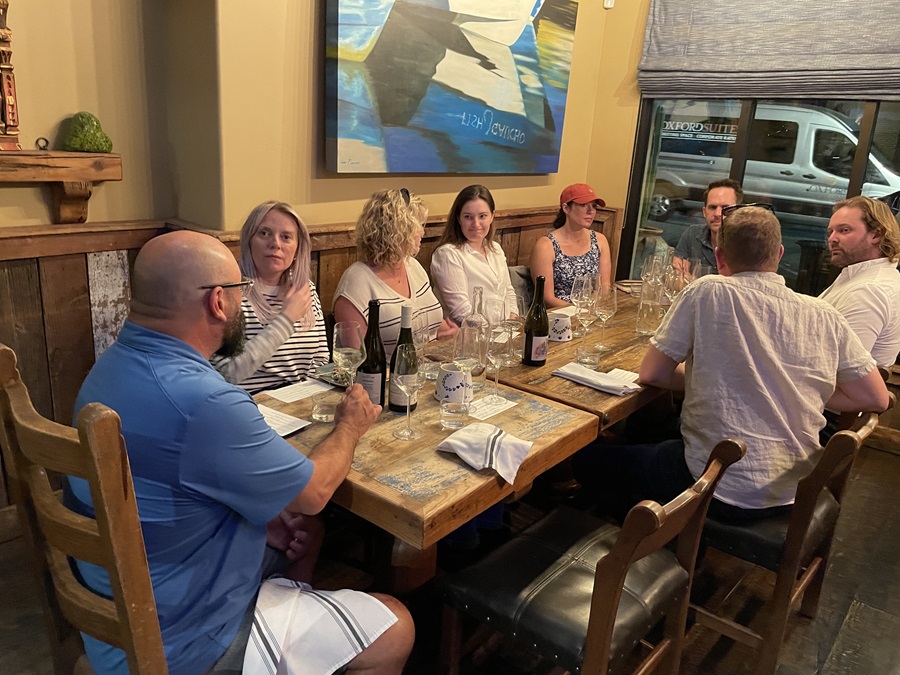
Vermentino is a well-known varietal from Southern Italy, Liguria and also from Southern France. According to Jason Haas of Tablas Creek, Vermentino was sent by accident to Tablas Creek, along with Tannat when the winery and region was just starting to experiment with different red varieties.
Vermentino pairs beautifully with fin fish, shrimp, and other seafood, so dinner had to be at the downtown hipster restaurant Fish Gaucho. Each of our winery guests poured a Vermentino during the multiple meal courses, including Jason Haas of Tablas Creek Vineyard, Nicole Pease of Paix Sur Terre, and Amanda Gorter of Robert Hall Winery. I can unconditionally state that each wine tasted was unique, well-structured, and thoughtfully produced.
These are all highly regarded wineries that are worth following on Instagram – @PaixSurTerreWines, @roberthallwinery, and @TablasCreek – and visiting on your next trip to Paso.
Adelaida District
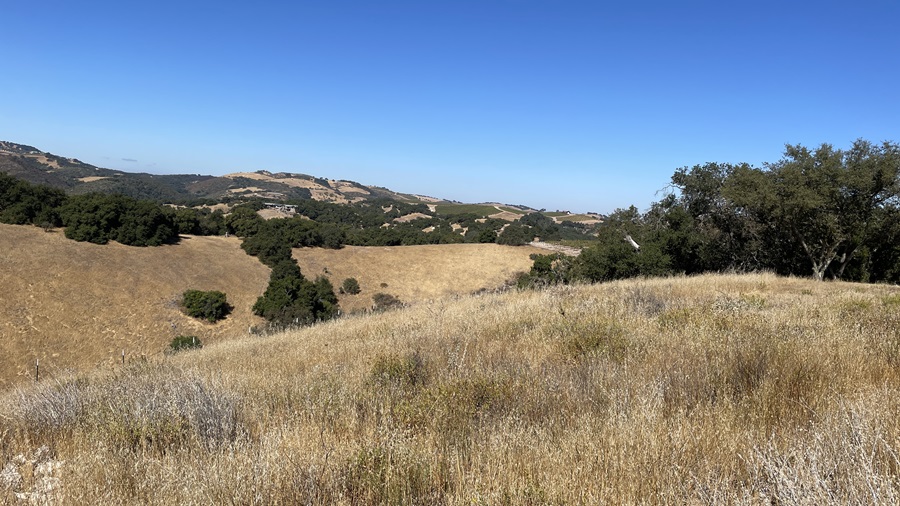
The Adelaida District is well known by wine travelers and visitors for a reason. It’s dramatic. High elevation, close proximity to the ocean, rolling hills, and calcareous shale (read: limestone) soils make for highly structured full acidity and medium-grained tannins, perfect for Bordeaux and Rhone varieties.
We met Alex Villicana at Villicana Winery’s estate vineyard atop Peachy Canyon, showcasing a view across the Adelaida. No surprise that the winemakers joining us were Jason Joyce of Calcareous Vineyard, accompanied by Philipp Pfunder Law Estate Wine. Imagine tasting wine on top of that hill on an early summer morning, the thin veil of fog slowly lifting, revealing rolling gold hills and green vineyards. LP record scratch – this experience is not available to the public, Dear Reader – however, each winery has tasting rooms with grand views and the same great wines, so don’t despair.
There were too many wines to count, but Rhone varieties sang to me that morning. I particularly liked the white Rhone wines and single variety Grenache and GSM blends. Trust me, you can’t go wrong with any wines from these folks. These are good people, and solid brands. Follow them on Instagram – @calcareouswine, @lawestatewines, and Villicana Winery & Distillery – and visit on your next Paso trip.
Dry Farming at Le Cuvier
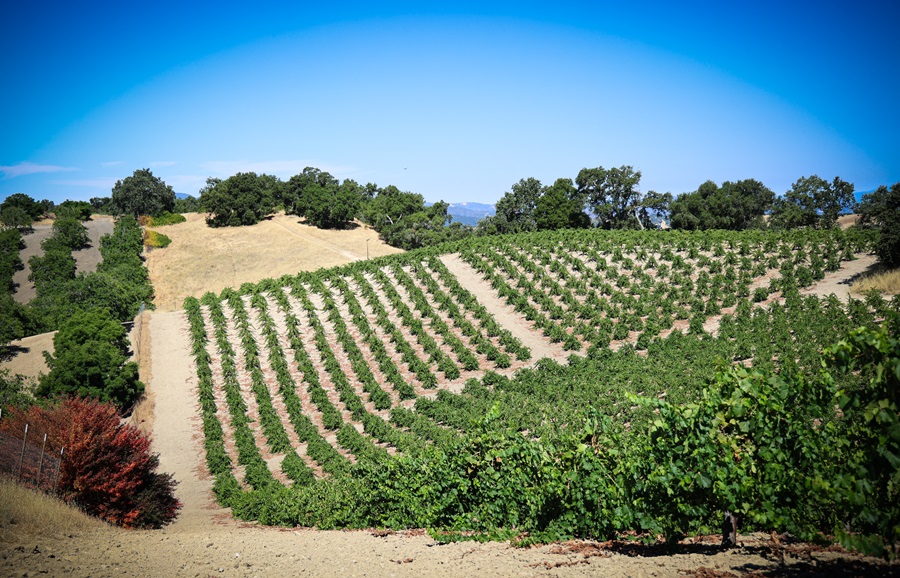
How is it possible to dry farm in an arid place like Paso Robles?
This was the question we asked at Le Cuvier. We met three committed and convincing winemakers who discussed the merits of dry farming. Clay Selkirk of Le Cuvier, Steve Beck of Loma Seca, and Ishka Stanislaus of Guyomar Wines. They are the leading advocates for the growing, environmental benefits, and wine style and quality resultant of dry farming.
Why do they dry farm? There are many reasons. They are growing on the aforementioned calcareous soil type which absorbs and retains water. The vine roots are quite deep, with up to 25’ root systems, so they are less affected by extreme weather and climate conditions, and find their own moisture. “Old School Farming,” says Ishka of Guyomar Wines. “Made in the vineyard,” says Steve Beck of Loma Seca. I agree. It is the way most vineyards have been farmed for eons in France for instance. Dry, organic, and minimal intervention. Let nature dictate but guide if you must.
We enjoyed an “Orange” Viognier, and several Zinfandels and it was an exceptional meal and pairing. This is a highly recommended stop for lunch. The tasting room and restaurant is where we tasted wines and dined, and you can too, 11-5pm Friday through Monday.
Go visit these wineries on your next visit to Paso and learn more about their approach to farming and sustainability. Follow them on Instagram – @lecuvierwinery, @lomasecavineyards, and @guyomarwinecellars.
Glamping with Millennials

How to make wine fun and approachable for folks in their mid-late 30s? Focus on the values of your peers of course – sustainability, authenticity, and experiential marketing. Shall we meet those wine-soaked millennials who made big commitments leaving their day jobs in Los Angeles for PR wine country?
Let’s go camping and winetasting! Dina and Jeff Hevert of Vinyl Vineyards call it glamping. I call it affordable elegance. Vinyl Vineyards is a 120-acre vineyard oasis with luxury bungalows, homes, RVs, trailers and camping rentals, and of course great wine, LPs and music all day long, and occasional concerts at night. They were kind enough to host our group of writers and show us a good time.
Joining us was another millennial wine brand, Mike and Magdelena of The Blending Lab. The Blending Lab is a 10-year-old business not only catering to Millennials but a diverse audience spanning various age groups, demographics and communities. Anyone who wants direct educational experiences will enjoy their custom blending classes and home blending kits. Their goal is to make wine personal and approachable.
RELATED: Learn More About Michael Keller of The Blending Lab
And finally, we met Erin Barrett Sparrow of High Camp Wines. HCW vineyards and tasting room is owned by a multi-generational family of farmers and ranchers in the San Miguel District, the most northern in PR. We didn’t visit but you can. It’s a 350-acre farm with sheep, vineyards, a tasting room and a large picnic area that allows outside food. Come out and stay for a spell.
We tasted, we spat, we chatted, and we loved it. Easy going smart young peeps. You will like them too. Please follow these folks and the arc of their wine careers on Instagram @TheBlendingLab, @HighCampWines, and @VinylVineyards.
Tin City, an Urban Wine Trail
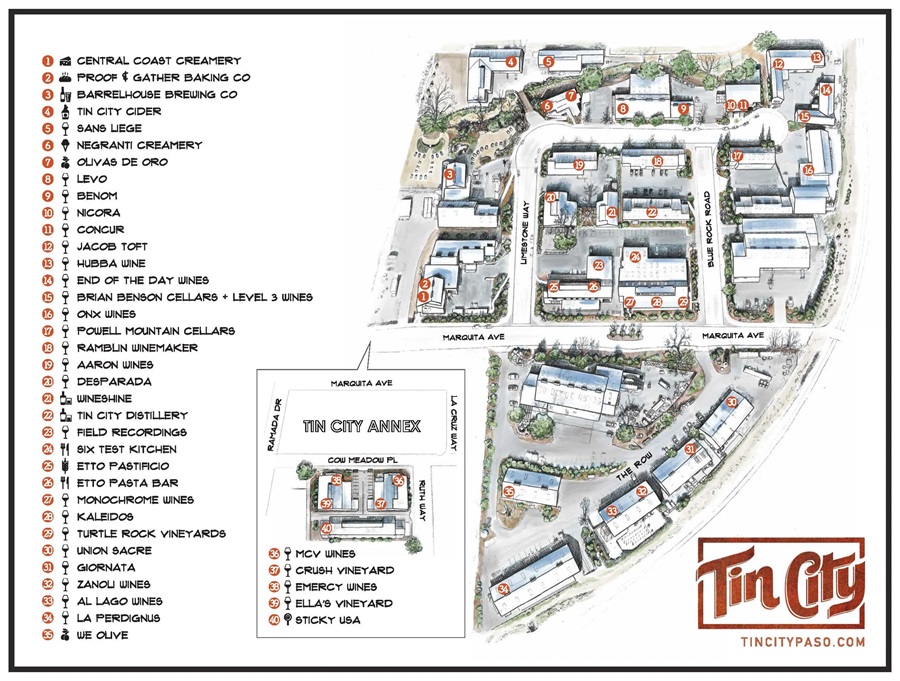
Tasting and dining in Tin City is an alternative urban wine trail option to heading into the hills. You can do it all right here in central PR. Tin City is an industrial hub for urban winemakers, cideries, breweries distilleries, restaurants, shops and much more, with over 40 different businesses residing here. Dare I say, an adult playground?
We met three multi-business multi-tasking entrepreneurial wineries for dinner at ETTO Pasta Bar in Tin City. Each winery has supplemented its winery business by adding another enterprise. And they aren’t alone. Paso Robles is one of the most innovative and energetic wine regions I’ve visited.
Brian and Stephy Terrizzi of Giornata Wines hosted us. They are also the owners of ETTO Pasta Bar and ETTO Pastificio in Tin City. They founded Giornata in 2006 and now produce about 5,000 cases of Italian varieties. ETTO followed in 2022, because they needed another project, and is now a local’s favorite. Take a look at the restaurant site and menu and you’ll understand why. Follow them on Insta @giornatawines.
Don & Claudia Burns of Turtle Rock Vineyards produce about 3,200 cases of wine and also distilled spirits at Tin City Distilling, and they are talking about starting a coffee roastery. Learn more on their websites and plan to taste when you next visit. Follow them on Insta @turtlerockvineyards and @tincitydistilling.
Kara and Curt Schlachlin of Sans Liege Wines have produced Rhone varieties since 2006, and also own and operate Tin City Cider, a Brittany or Normandie French-style cidery. Learn more on their websites and plan to taste when you next visit. Follow them on Insta @sanliege and @tincitycider.
Vineyard Cycling at Castoro Cellars
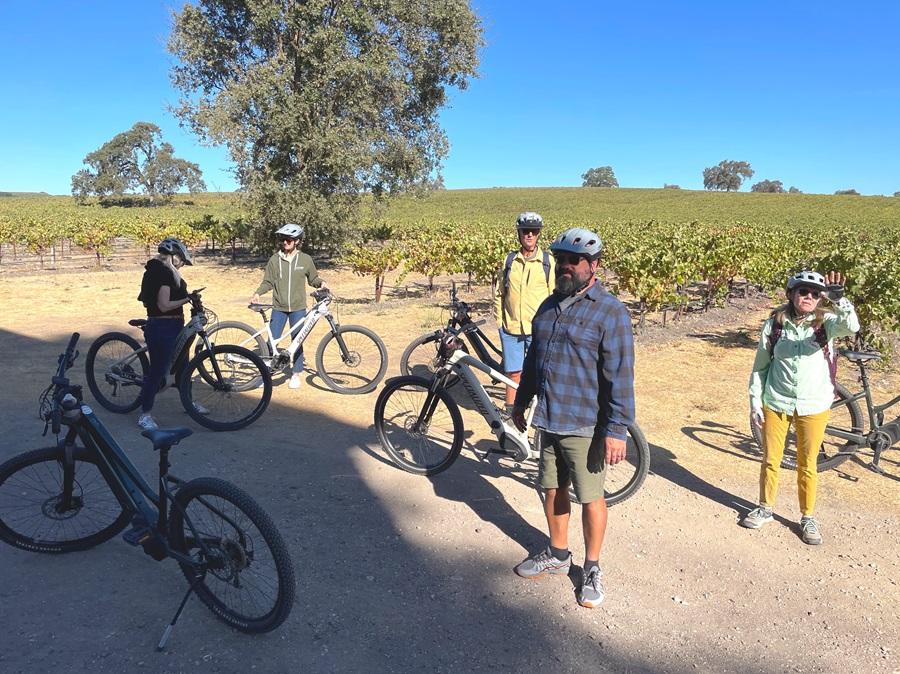
Castoro Cellars, located in Templeton is a 1,600-acre property offering a variety of consumer experiences, including e-bike cycling loop tours and disc golf course. Castoro Cellars was established 40 years ago. They farm 1,400 acres that are certified organic by CCOF and all the vineyards are SIP Certified. Their commitment to sustainability goes beyond vine farming to one of the largest solar panel systems in the area, and the use of EV Powered Tractors.
We were greeted by Kelsey McClure of Castoro, and Melissa and Jeff Lindenthal of VineCycle, owners of the e-bike touring company, and off we went. The 4.5-mile trail was a piece of cake under e-power. There were planned stops along the way to wine taste in the vineyards and under the California live oak trees. It’s a lovely pairing experience to spend a morning – e-bike tour, some disc golf, wine tasting along the way, followed by sit-down sampling in the tasting room. Bring a picnic lunch and grab a bottle of the Belena “Whale Rock” Vineyard White Blend to pair and share with friends.
The Castoro Cellars tasting room is open 10am-5:30pm Daily, with all experiences available and bookable. Follow on Instagram @castorocellars and @vinecycletours.
Lunch at Parchetto Bistro
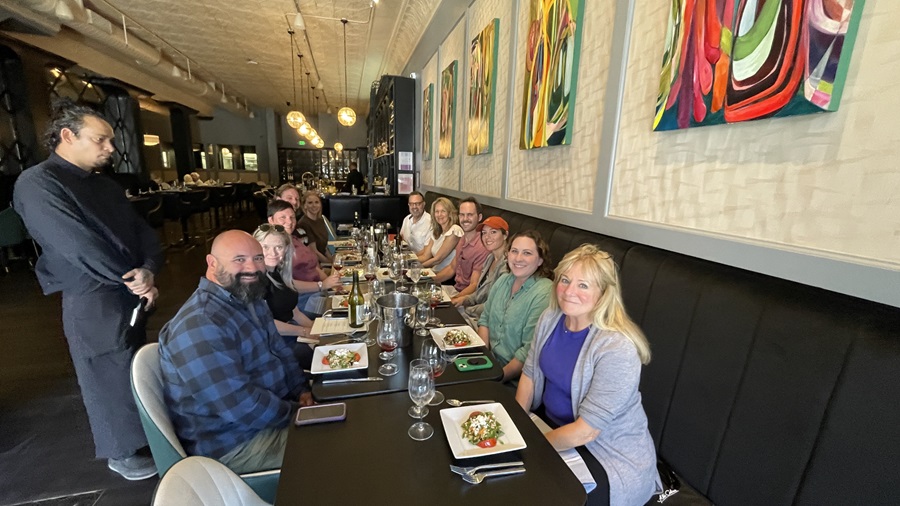
We headed back to the River Lodge Paso Robles our refuge for the trip, to freshen up before lunch at Parchetto Bistro in downtown PR. Parchetto is a full-service restaurant serving both lunch and dinner. The restaurant focuses on steak, duck, seafood and fresh local produce. You’ll find a full bar, a robust wine list, and exceptional attention to detail and service. We tasted delightful Rhone blends and Bordeaux varieties, and if you visit any of the following wineries you’ll also find rosé and whites to explore.
Our lunch guests, all from family-run wineries, are considered leaders in the wine community. They included Maggie Tillman from Alta Colina Vineyard, Chloe Asseo-Fabre from L’Aventure Winery, and Michelle Thacher from Thacher Winery. Carole MacDonal, our host and owner of Parchetto also joined us. Our conversation led us to what might be the theme of the trip, the Paso Robles “Wine Lifestyle”. That is, that wine as in life, can be fun, approachable, and profound.
Follow these food and wine characters on Instagram @parchettopaso, @laventurewine, @thacherwinery, and @altacolina and include them in your trip plans.
Better For You
Greenwashing is the intentional practice of implying something is “Better for You”. Terms like “natural”, “farm fresh”, “sustainable”, and even “organic” can be misused. This was not the case with at Niner Wine Estates where we enjoyed an al fresco dinner with Andy Niner of Niner Wine Estates, Cris Cherry of Villa Creek, and Josh Messina of Jada Vineyard. Each has certifications and growing practices including Certified Organic, Regenerative Organic, Demeter BioDynmaic, Certified Sustainable and LEED Certification. This group stands apart, walking the walk, not just talking the talk of sustainability.
Of course, you might imagine that the restaurant was exceptional and you’d be right. We were surrounded by vineyards with views of Heart Hill. The restaurant has a regenerative “Chef’s Garden” serving home-grown produce and offers a seasonal lunch menu on a reservation basis. They have received numerous accolades from wine and food publications and I hope you seek out this dining experience, not to mention the wines of each of the producers. You can follow them on Instagram @ninerwineestates, @villacreekcellars, and @jadawinery.
Sparkling Paso

It’s time to celebrate. We’re spending the last day of the press trip on the eastern side of PR, starting out at Rava Wines, the key driver of the sparkling wine movement in Paso. Rava Wines is a 3rd generation brand founded in 1996 and is located in El Pomar AVA. The 80-acre estate was formerly a horse ranch purchased in 2010. They built a state-of-the-art sparkling wine processing facility focused on the classical French method of making bubbles. An estimated 25 other wineries make sparkling here, including Phil LaMontagne of Bodega de Edgar and Jason Bushong of Bushong Vintage Company. Leading us on tour of the processing facility is Sherrie Holzer of RAVA.
RAVA’s tasting room is open daily 10-5pm. Charcuterie and savory snacks are available for purchase. There’s a state-of-the-art indoor concert space onsite that can seat about 1,000 people and an outdoor space adjacent to the tasting room. Onsite weddings are accommodated for up to 1,000 guests.
You can follow these sparkling producers on Instagram @bushongvintagecompany, @bodegadeedgar, and @ravawines.
Backroads Paso
Dresser Winery is a family-owned 20-acre property sitting pretty at over 1,000 feet with an onsite five-bedroom home/ AirBnB. Kory and Catherine Burke of Dresser Winery purchased the property in 2019. The tasting room is open daily (except Mondays). Check the website for hours. You’ll find six tasting and/or food and hiking tour experiences on the site.
RELATED: Read the Interview with Kory Burke of Dresser Vineyard
We met Chanda Brown of Cass Winery, Nicole Healey-Finn of Bella Luna Winery and Erin Faulkner of Defiance Vineyard for tasting and a catered lunch. This is part of a core group of 25 wineries that have banded together to form Backroads Wine Trail, an ideal discovery adventure for Winetravelers.
We toured the home, tasting room and settled into the dining room for an animated discussion of the east side, backroads touring and of course, wine tasting. The east side growers traditionally sold their grapes to Napa and other regions, and have rallied in recent times to highlight their own brands. The ranching legacy is a bit more apparent, and There is a bit of wild west happening here in the wild east.
Today, wineries like Cass Winery have multiple experiences onsite including several tasting options, a B&B onsite, and Camp Cass. Ready for this pairing? You can reserve e-bikes and ride the vines, practice your archery, ax throwing or painting; take an olive oil class, ride a horse and have several wine and food education offerings. Defiance Vineyard offers wine tastings on the weekends, as well as extensive home kitchen recipes and wine and food pairing suggestions on their website. Bella Luna offers tastings inside the working winery, virtual tasting kits and a harvest intern experience. Roll up your sleeves and dive in.
Follow these folks on Instagram at @dresser_winery, @bellalunawine, @cass_winery, and @defiancevineyard.
Truffles in The Templeton Gap
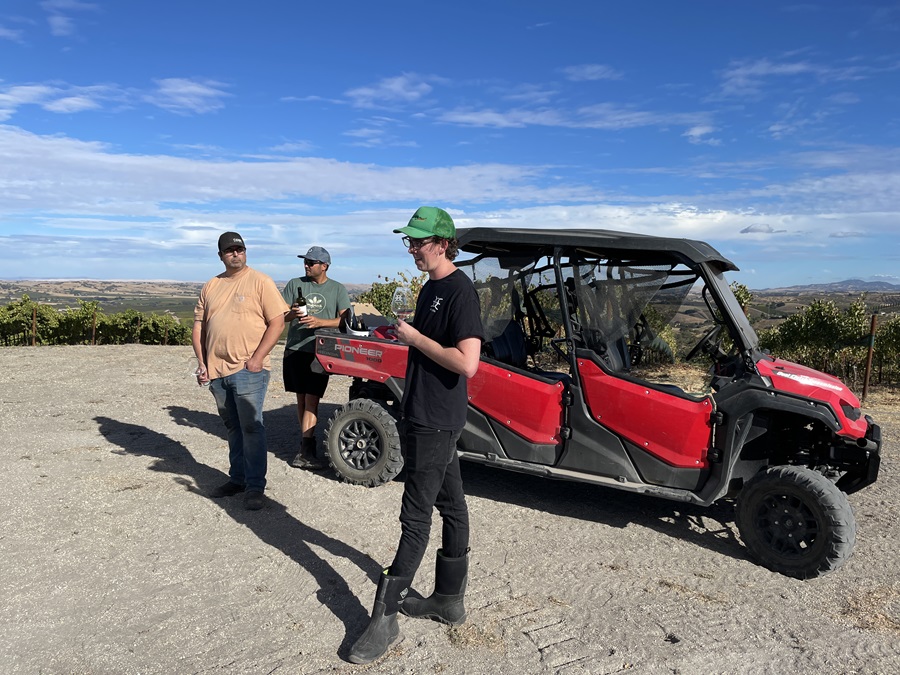
Caelesta Vineyard, on 30 acres, is another example of farming diversification. They offer vineyard tours and wine tastings Thursday-Monday 11-5pm. You can also visit and tour the “Truffiere”, i.e. Truffle Farm. They planted black truffles seven years ago amongst holly oak trees on the property. They are one of only three producers on the West Coast. You can experience truffle hunts and tastings, special lunch and dinner tastings, or join harvest tours from mid-December to February. Pairing wine & truffles, anyone?
We met a group of young rebels who are beginning to break into the Paso wine scene on their own terms. All have in common sourcing fruit from Caelesta Vineyard. Brian Farrell of Caelesta met and toured us through the truffiere, followed by an ATV run to the top of the vineyard. We met Aaron Jackson of Aaron Wines, and Andy Neja of Cairjn Wine Cellars and tasted their juice from Caelesta.
You can follow these young rebels on Instagram @caelesta_wines, @aaronwines, and @cairjnwines.
A Bloomin’ Good Time
Our wrap up dinner was at In Bloom Restaurant. The menu is beyond creative and food plating is an art. Check out the menu for sourcing from local farms. The restaurant has become where winemakers go to be seen and talk shop, and we got to hang out with three interesting wine characters for pre-dinner drinks (excellent mixology), wines (an exceptional local and international list) and dinner. Joining us were Ryan Kemp from Adelaida Vineyards, Kit Kuyper of Hawks Hill Ranch, and Pete Turrone of Booker Vineyard. We tasted several wines during dinner. My favorites were the 2021 Ripper Grenache, produced in concrete and stainless tanks from Booker Vineyard; the 2022 Picpoul Blanc from Adelaida, and the 2021 Moth to Flame Chardonnay from Hawks Hill Ranch.
RELATED: Read the Interview with Pete Turrone of Brooker Vineyard
The restaurant is a must-do when you visit Paso, as are these three wineries. You can follow them on Instagram @adelaidavineyards, @hawkshillranch, @bookervineyard, and @eatinbloom.
Final Thoughts
I was already planning to return before I left. Paso Robles has become the go-to region in California for Winetravelers who prefer a smaller and more approachable wine country experience. With over 200 wineries, I’m certain I have just scratched the surface and will be back, but it was a great start.
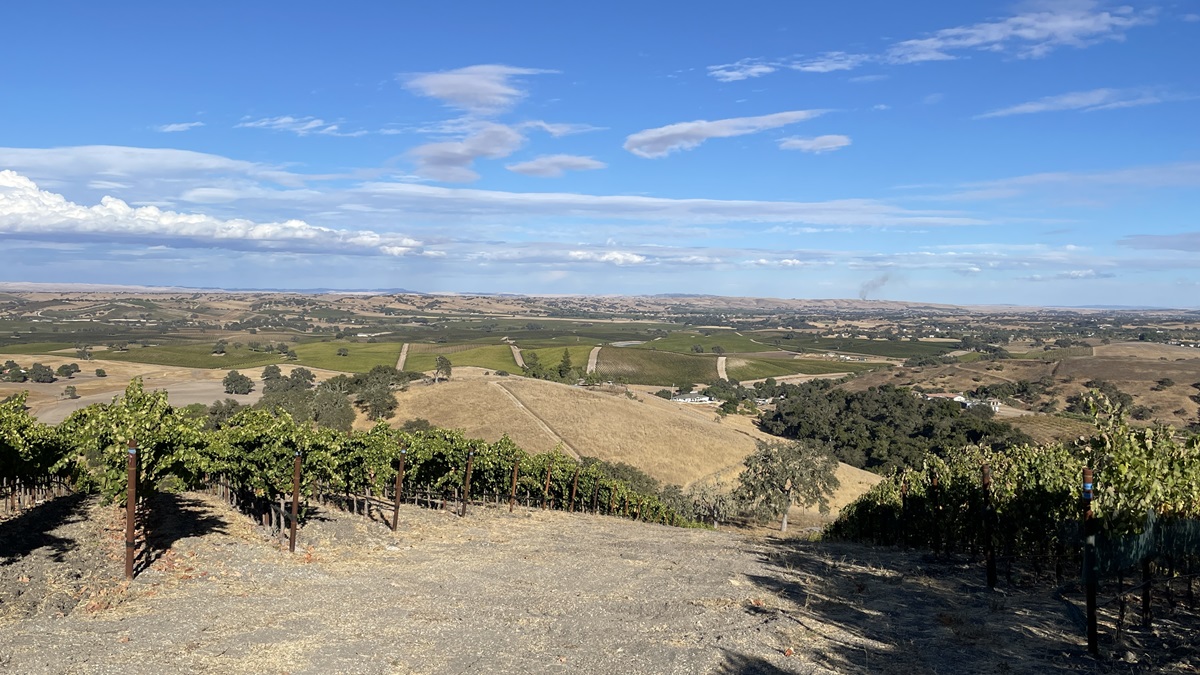
Love Paso wine region. Justin and Turley are my fave wineries.
Thanks for the comment. We have some BC Wine love coming your way soon 🙂